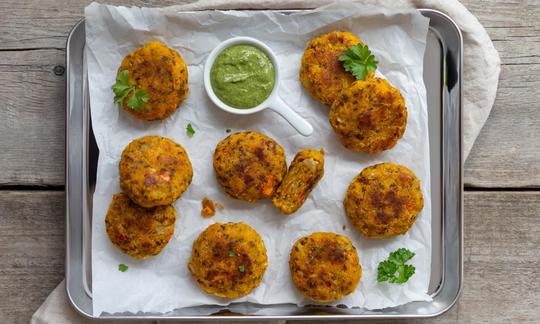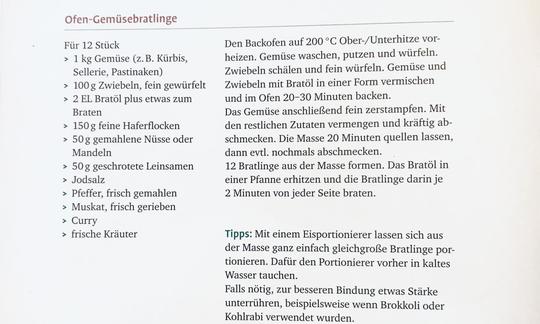Oven-baked vegetable patties with oat flakes and linseed
vegan
Ingredients (for servings, )
| For the oven vegetables | |
|---|---|
| 25 oz | Butternut squash, raw (pear squash), one butternut squash |
| 11 oz | Celeriac, raw (organic?) |
| 3 ½ oz | Onions, raw (organic?) |
| 2 tbsp | Rapeseed oil, refined (organic?) (0.98 oz) |
| For the patties | |
| 5 ½ oz | Oat flakes (raw?, organic?) |
| 1 ¾ oz | Walnuts (tree nuts), raw (organic?) |
| 1 ¾ oz | Linseed, raw, organic? (golden linseed, flax) |
| Spices | |
| 1 dash | Table salt (table salt, raw?, organic?) (0.01 oz) |
| 1 dash | Black pepper (organic?, raw?) (0.00 oz) |
| 1 Msp. | Nutmeg, ground or grated (raw, organic?) (0.01 oz) |
| 1 tbsp | Curry powder (organic?, raw?) (0.22 oz) |
| 3 tbsp | Parsley, fresh, raw (leaf parsley, parsley) (0.40 oz) |
Equipment
- skillet (frying pan)
- stove
- coffee grinder, electric
- oven
Type of preparation
- cook
- fry
- bake
- chop or grind
- season to taste
- remove the skin
- Quellen lassen (ausquellen)
Preparation
For the oven vegetables
Preheat the oven to 200 °C top/bottom heat.
Wash, clean and dice the vegetables. Peel the onions and dice finely. Mix the vegetables and onions with oil in a dish and bake in the oven for 20-30 minutes.You can be flexible when choosing vegetables. The author gives pumpkin, celery and parsnip as examples, which you can use together, combined with other vegetables or on their own.
If necessary, reduce the oven temperature to 180 °C. We recommend adding the onions a little later, as they can easily burn.
The author uses any frying oil. We chose refined rapeseed oil (see also tips).
Preparation of the patties
Either grind the walnuts fresh or use ground ones. Grind the flax seeds in a coffee grinder.
Then mash the vegetables finely. Mix with the remaining ingredients and season well to taste. Allow the mixture to swell for 20 minutes, then season again if necessary.Instead of walnuts, you can also use other ground nuts or almonds. We deliberately used walnuts here (see tips). In the original recipe, the author specified fresh herbs as an ingredient. We chose parsley. You can also use coriander or other herbs here.
You can also buy ground flax seeds if you don't have a coffee grinder or something similar.Form 12 patties from the mixture. Heat some oil in a pan and fry the patties for 2 minutes on each side.
|
Nutritional Information per person
Convert per 100g
|
2000 kcal | |
|---|---|---|
| Energy | 435 kcal | 21.7% |
| Fat/Lipids | 24 g | 34.1% |
| Saturated Fats | 2.5 g | 12.3% |
| Carbohydrates (inc.dietary fiber) | 48 g | 17.7% |
| Sugars | 8.3 g | 9.2% |
| Fiber | 13 g | 50.1% |
| Protein/Albumin | 13 g | 25.2% |
| Cooking Salt (Na:126.9 mg) | 322 mg | 13.4% |
| Essential micronutrients with the highest proportions | per person | 2000 kcal | |
|---|---|---|---|
| Fat | Alpha-Linolenic acid; ALA; 18:3 omega-3 | 4.6 g | 230.0% |
| Min | Manganese, Mn | 2.7 mg | 135.0% |
| Vit | Vitamin A, as RAE | 768 µg | 96.0% |
| Fat | Linoleic acid; LA; 18:2 omega-6 | 7.9 g | 79.0% |
| Min | Copper, Cu | 0.74 mg | 75.0% |
| Vit | Vitamin K | 53 µg | 70.0% |
| Elem | Phosphorus, P | 434 mg | 62.0% |
| Prot | Tryptophan (Trp, W) | 0.15 g | 59.0% |
| Vit | Vitamin C (ascorbic acid) | 46 mg | 57.0% |
| Vit | Thiamine (vitamin B1) | 0.56 mg | 51.0% |
Detailed Nutritional Information per Person for this Recipe
The majority of the nutritional information comes from the USDA (US Department of Agriculture). This means that the information for natural products is often incomplete or only given within broader categories, whereas in most cases products made from these have more complete information displayed.
If we take flaxseed, for example, the important essential amino acid ALA (omega-3) is only included in an overarching category whereas for flaxseed oil ALA is listed specifically. In time, we will be able to change this, but it will require a lot of work. An “i” appears behind ingredients that have been adjusted and an explanation appears when you hover over this symbol.
For Erb Muesli, the original calculations resulted in 48 % of the daily requirement of ALA — but with the correction, we see that the muesli actually covers >100 % of the necessary recommendation for the omega-3 fatty acid ALA. Our goal is to eventually be able to compare the nutritional value of our recipes with those that are used in conventional western lifestyles.
| Essential fatty acids | per person | 2000 kcal |
|---|---|---|
| Alpha-Linolenic acid; ALA; 18:3 omega-3 | 4.6 g | 230.0% |
| Linoleic acid; LA; 18:2 omega-6 | 7.9 g | 79.0% |
| Essential amino acids | per person | 2000 kcal |
|---|---|---|
| Tryptophan (Trp, W) | 0.15 g | 59.0% |
| Threonine (Thr, T) | 0.37 g | 40.0% |
| Isoleucine (Ile, I) | 0.46 g | 37.0% |
| Valine (Val, V) | 0.58 g | 36.0% |
| Phenylalanine (Phe, F) | 0.54 g | 35.0% |
| Leucine (Leu, L) | 0.79 g | 33.0% |
| Lysine (Lys, K) | 0.52 g | 28.0% |
| Methionine (Met, M) | 0.18 g | 20.0% |
| Vitamins | per person | 2000 kcal |
|---|---|---|
| Vitamin A, as RAE | 768 µg | 96.0% |
| Vitamin K | 53 µg | 70.0% |
| Vitamin C (ascorbic acid) | 46 mg | 57.0% |
| Thiamine (vitamin B1) | 0.56 mg | 51.0% |
| Folate, as the active form of folic acid (née vitamin B9 and | 84 µg | 42.0% |
| Vitamin B6 (pyridoxine) | 0.50 mg | 36.0% |
| Biotin (ex vitamin B7, H) | 15 µg | 30.0% |
| Pantothenic acid (vitamin B5) | 1.2 mg | 20.0% |
| Riboflavin (vitamin B2) | 0.23 mg | 16.0% |
| Niacin (née vitamin B3) | 2.4 mg | 15.0% |
| Vitamin E, as a-TEs | 1.2 mg | 10.0% |
| Essential macroelements (macronutrients) | per person | 2000 kcal |
|---|---|---|
| Phosphorus, P | 434 mg | 62.0% |
| Potassium, K | 977 mg | 49.0% |
| Magnesium, Mg | 179 mg | 48.0% |
| Calcium, Ca | 151 mg | 19.0% |
| Sodium, Na | 127 mg | 16.0% |
| Essential trace elements (micronutrients) | per person | 2000 kcal |
|---|---|---|
| Manganese, Mn | 2.7 mg | 135.0% |
| Copper, Cu | 0.74 mg | 75.0% |
| Iron, Fe | 4.5 mg | 32.0% |
| Zinc, Zn | 3.2 mg | 32.0% |
| Selenium, Se | 16 µg | 30.0% |
| Iod, I (Jod, J) | 1.4 µg | 1.0% |
| Fluorine, F | 0.29 µg | < 0.1% |
The oven-baked vegetable patties with oat flakes and linseed get their spicy note from curry.
Serving size: The specified amount for 4 servings is sufficient for 12 patties.
Nutrient profile: According to GDA guidelines, one portion covers practically twice the average daily requirement of omega-3 fatty acids. Manganese, which plays a role in the formation of cartilage tissue, is covered by over 100%, as is vitamin A. The latter, a fat-soluble vitamin, plays an important role in the vision process. The ratio of omega-6 to omega-3 fatty acids is 2:1, well below the maximum recommended ratio of 5:1. More on this under: Vegans often eat unhealthily. Avoidable nutritional errors.
However, the vegetables lose some of their nutrients when heated during frying and baking. Since the nutrient profile primarily refers to uncooked ingredients, the values are actually somewhat lower.
Butternut squash: The butternut squash has a relatively thin skin and a high proportion of tender, light orange flesh, which has a buttery, slightly nutty aroma and melts on the tongue. The butternut squash has a high content of beta-carotene, which is good for skin, hair and eyesight. 100g of butternut squash covers around 80% of the daily requirement of beta-carotene. It also contains plenty of vitamin C. Compared to other types of squash, it contains relatively high calories but hardly any fat.
By the way, butternut squash can also be eaten raw, for example cut into fine strips or grated into a salad or made into a smoothie.
Celery: Celeriac is a cultivated form of marsh celery. Celeriac has a spicy taste that stimulates the appetite and digestion, which it owes to its essential oils. In naturopathy, it is used to support rheumatism, stomach and intestinal disorders, and kidney and bladder problems.
Walnut: The real walnut, also called tree nut, has the highest proportion of linolenic acid (an omega-3 fatty acid that is healthy for the heart) of all nuts. It is also rich in vitamin E, zinc (an important trace element for the liver and hair, among other things) and potassium (for the heart muscle, among other things).
Flaxseed: Flaxseed is the seed of the flax plant (common flax, Linum usitatissimum). Flaxseed has a slightly nutty taste and a fat content of around 40%. With around 50% of the polyunsaturated omega-3 fatty acid ALA, this has the highest concentration of omega-3 fatty acids of all known vegetable oils. Those who eat a lot of industrial food should increase the amount of flaxseed in their diet and correct nutritional errors in this regard.
Walnuts compared to other nuts and almonds: Compared to other nuts and almonds, walnuts contain a higher proportion of the particularly valuable omega-3 fatty acids, which play a role in reducing inflammatory processes.
Celery: Peeled bulbs discolor quickly. Drizzle the raw bulb with lemon juice and add vinegar to help prevent this.
Oil and heating: Cold-pressed rapeseed oil is not suitable in this case, as cold-pressed oils can only be heated slightly, in the case of cold-pressed rapeseed oil up to a maximum of 120 °C, as otherwise harmful substances are created. See the following link ( cold-pressed rapeseed oil). But refined rapeseed oil should also be heated up to a maximum of 180 °C. Under no circumstances should it start to smoke, although decomposition will begin before that.
Vary the vegetables: As stated by the author, you can also use other vegetables alone or in combination. You can also use any kind of herbs you like. This will of course change the nutrient content, but the favorable ratio of omega-6 to omega-3 fatty acids, which is mainly due to the flax seeds and walnuts, remains the same.





